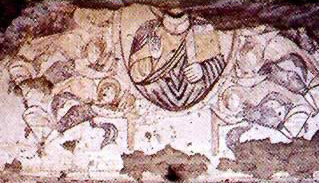The Monastery at Qubbat Al-Hawa
The Other Monastery at Aswan
by Jimmy Dunn

One of the best known monasteries, and a frequent stop on most tours that stop in Aswan in far Upper Egypt, is Deir Anba Simaan also known as Deir Anba Hadra (Hatre), but best known as the Monastery of St. Simeon. For many tourists, a visit to this monastery may constitute the only camel ride while in Egypt. However, there is another monastery in the general vicinity of Aswan, and in fact conveniently located in the area of the pharaonic Tombs of the Nobles midway between the summit of a hill at Qubbat al-Hawa and the Nile River. It lies about one kilometer from Elephantine Island and in fact occupies part of the royal tombs.
This monastery is commonly referred to as that of St. George (Deir Mari Girgis), but in fact there is no conclusive evidence of that having been the monastery's actual name. Different names have been associated with this monastery, and it may have been called the Monastery of St. Laurentius, or the Monastery of the Savior. Also, the early thirteenth century church historian, Abu al-Makarim mentions a Monastery of Antony in the area. Irregardless, it is likely that this much smaller monastery was a dependency of the considerably larger Monastery of St. Simeon.

While predating the Fatimid Period (972-1171), that was the golden era of this monastery, when a large residential structure of several stories consisting of a central corridor and sleeping rooms was built.
The ruins of a church stand before the pharaonic tomb of Khune. This church, which follows the plan of an octagon-domed structure, was probably built after the beginning of the Fatimid Period but before the end of the eleventh century. Only at the end of the twentieth century (1998), was debris removed from the area of this church, which unearthed beautiful wall paintings and Coptic (Egyptian Christian) and Arabic Texts.

In the west wall of the church is an apse adorned with a two-zoned composition which was a popular style in monastic painting. The upper section of this composition depicts Christ in a mandorla. His right hand is raised in a posture of blessing, while in his left hand he holds a book. The mandorla is supported by six angels in full flight. Below this scene on the lower part of the apse, the Holy Virgin stands amidst the twelve Apostles.


There remains considerable conservatory work to be performed at this monastery, for there are many other Coptic and Arabic text preserved under a thin layer of plaster. However, these texts and the murals of the church are very important for the history of Christianity and monasticism at Aswan, and the paintings of the church provide invaluable documentation for the study of Coptic art at the beginning of the second millennium.
Return to Christian Monasteries of Egypt
References:
|
Title |
Author |
Date |
Publisher |
Reference Number |
|
2000 Years of Coptic Christianity |
Meinardus, Otto F. A. |
1999 |
American University in Cairo Press, The |
ISBN 977 424 5113 |
|
Coptic Monasteries: Egypt's Monastic Art and Architecture |
Gabra, Gawdat |
2002 |
American University in Cairo Press, The |
ISBN 977 424 691 8 |
|
Churches and Monasteries of Egypt and Some Neighboring Countries, The |
Abu Salih, The Armenian, Edited and Translated by Evetts, B.T.A. |
2001 |
Gorgias Press |
ISBN 0-9715986-7-3 |

